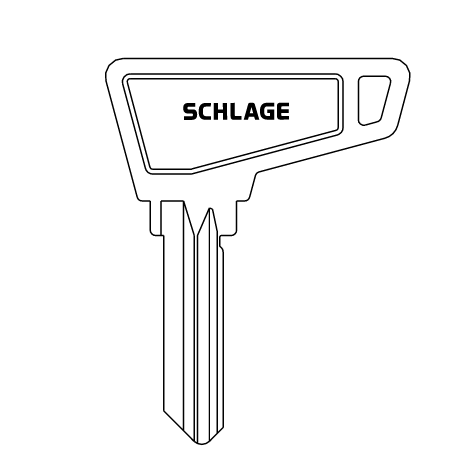In this month’s Decoded column, I answer a question about the accessibility requirements for keys and credentials. If you have a code question you’d like to see answered in my column, you can submit it by visiting iDigHardware.com/decoded-qa.
This post will be published in Doors & Hardware


Although keys require tight grasping, pinching, and twisting of the wrist, they are not prohibited by the accessibility standards.
The accessibility standards that are commonly used across the United States are the ADA Standards for Accessible Design and ICC A117.1 – Accessible and Usable Buildings and Facilities. These standards state that door hardware must be operable without tight grasping, pinching, or twisting of the wrist. This requirement has raised this month’s Decoded question:
If the accessibility standards require hardware to be operable without tight grasping, pinching, or twisting of the wrist, how are keys addressed?
The accessibility standards do not include very prescriptive requirements related to door hardware. In addition to the prohibition on tight grasping, pinching, and twisting of the wrist, both sets of standards require handles, pulls, latches, locks, and other operable parts of door and gate hardware to have a shape that is easy to grasp, and that is operable with one hand. Releasing hardware must be mounted between 34 inches and 48 inches above the floor, or as required by state or local standards.
Door hardware must also meet the operable force limitations stated in the applicable standard. ICC A117.1 is aligned with the International Building Code (IBC), limiting the operable force for door hardware to 15 pounds of forward pushing or pulling motion or 28 inch-pounds of rotational motion. The ADA standards limit operable force for operable parts to a maximum of 5 pounds.
Beyond these requirements, the standards do not address details such as the minimum length of a thumbturn, the required shape of a lever handle, or the clearance around the hardware, other than the somewhat vague prohibition on tight grasping, pinching, or twisting of the wrist. As keys require someone to not only grasp, pinch, and twist, but also to have the dexterity to insert the key into the cylinder, how is this compliant with the standards? This also applies to some types of electronic credentials.
This question is answered in the U.S. Access Board’s Guide to the ADA Accessibility Standards. Keys are not prohibited by the accessibility standards; they are not addressed by the standards at all, because a key is not considered an operable part of the hardware. The ICC A117.1 Commentary confirms that non-fixed portions of door hardware, such as keys or access cards, are not required to comply.

Keys and electronic credentials are not addressed by the accessibility standards, but access control credentials that require less hand or finger dexterity may be provided as an accommodation.
Operable parts are defined by both accessibility standards as: A component of an element used to insert or withdraw objects, or to activate, deactivate, or adjust the element. And what is an element? An architectural or mechanical component of a building, facility, space or site.
Although lever handles, thumbturns, or panic hardware touchpads would be considered operable parts subject to the requirements of the accessibility standards, components used to operate those parts – like keys and access control credentials – are not. With that said, some building occupants are unable to grasp and insert a key or a mag-stripe card. These users may need an accommodation to be made, such as electrified hardware with a proximity reader, which only requires the credential to be placed within the detection range.
To accommodate the widest range of building occupants, some of the key considerations are:
- Hardware should be usable with a loose grip or closed fist, although the standards do not specifically require hardware to be operable with a closed fist in order to comply.
- Sufficient knuckle clearance, 1-1/2 inches minimum, should be provided around and behind operable hardware such as levers, door pulls, and push bars.
- Door hardware that requires hand or finger dexterity, simultaneous actions, or fine motor skills, should be avoided.

Keys with extended bows are not mandated by the accessibility standards, but may be helpful to some users.
While key blanks with extended bows may be easier to use, these keys are not specifically required by the accessibility standards. Some state or local codes or building standards might require this type of key, but the key would still require tight grasping, pinching, and twisting of the wrist. Keypads that accept access-control codes are not specifically addressed by the standards, but they are typically acceptable because they do not require tight grasping, pinching, or twisting of the wrist to operate. There are other types of electronic credentials, such as proximity fobs and mobile applications that could facilitate easier access, even though they are not required by the standards.
As with any code question related to door openings, it’s best to check the adopted codes and standards for requirements specific to the location of the project. For further assistance, contact the Authority Having Jurisdiction (AHJ).
You need to login or register to bookmark/favorite this content.










Keys with extended bows were not well received when one company switched to a version of them 40 years ago.
Hi Bill –
Do you know what the objection was?
– Lori
Lori,
Consider those without fingers, blind or deaf when encountering keys or keypads.
Also code and ADA Standards aren’t always in alignment. As you know, “it depends” there is no one size fits all.
More sprcifically, some of the articles by others you share are not often up to date with code cites and may also differr from state to state. California CBC has many state specific differences from ICC and ANSI.
I enjoy and commend you for what you do.
Thanks ADAGuy – I don’t usually share articles from others (although I did share one recently). My articles are based on the model codes and referenced standards, and I always try to remember to note that state codes may differ. It’s impossible to keep up with them all, which is why I start with the model codes and our team of ACEs (Allegion Code Experts – https://idighardware.com/ace-network/) is responsible for being familiar with the local requirements.
If you ever come across something that’s outdated, I welcome your feedback. You can also note specific state differences in the comments.
– Lori